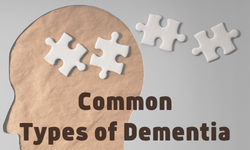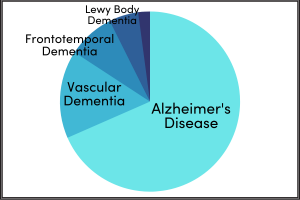
Dementia is a broad term used to describe a range of conditions that affect the brain. It is not a specific disease, but an umbrella term for several diseases characterized by the loss of cognitive functioning. In the same way that basketball and football fall under the category of sports, diseases like Alzheimer’s disease and Lewy body dementia fall under the category of dementia.
What these diseases have in common is that they affect the function of the brain. People diagnosed with a type of dementia will have a range of symptoms that affect their thinking abilities. The most common symptoms include memory loss, changes in behavior, and a decline in the ability to live independently.

The intensity of these symptoms can vary from person to person, which means some patients will need more assistance than others. Additionally, most types of dementia are progressive which means symptoms may worsen over time and unfortunately there is still no cure for any type of dementia.
Although we don’t know everything about dementia, research has given us the ability to identify and treat many of these diseases. The most common forms of progressive dementia include Alzheimer’s disease, vascular dementia, frontotemporal dementia, and Lewy body dementia.

Alzheimer’s Disease
The most common form of dementia is Alzheimer’s disease (AD), representing 60%-80% of all dementia diagnoses. The cause of AD is unknown, however, people with AD are often found to have a buildup of clumped proteins in the brain, referred to as plaques and tangles. Common symptoms of AD include short-term memory loss, changes in behavior, and a decreased ability to carry out normal functions like getting dressed or driving a car.
Vascular Dementia
Accounting for 10-20% of all dementia diagnoses, vascular dementia (VD) is any dementia that is caused by damage to the brain’s blood vessels. Conditions that decrease blood circulation, like a stroke blocking an artery, may cause damage to the brain from impaired blood flow. Factors that increase a person’s risk of stroke and heart disease (diabetes, hypertension, high cholesterol, smoking, etc.) also increase the risk of VD. Common symptoms of VD include memory loss, slowed thinking, and loss of interest in things or people they previously enjoyed. It is common for people with VD to experience behavioral changes, such as irritability, that make them choose to be isolated.
Frontotemporal Dementia
Brain disorders that affect the frontal and temporal lobes of the brain are classified as frontotemporal dementia (FD). FD represents about 10% of dementia diagnoses and is caused by an abnormal protein forming inside the brain cells of the frontal and temporal lobes, causing the lobes to shrink. These lobes are important for processing information, including emotions. As a result, people with FD usually have distinct changes in behavior, personality, and language. They may say things that are rude and inappropriate, become impulsive, and in some cases, lose the ability to speak.

Lewy Body Dementia
Lewy body dementia (LBD) accounts for about 4% of dementia diagnoses. Lewy bodies are protein deposits that develop in the nerve cells in the brain; a person with this type of dementia has a buildup of Lewy bodies in the parts of the brain involved in thinking and movement. Common symptoms of LBD include memory loss, hallucinations, and problems with motor control abilities such as tremors and slow movement. Unfortunately, it is often common for people with LBD to become depressed and lose interest in things they once enjoyed.

According to the CDC, dementia diagnoses are expected to reach almost 14 million by 2060. This is why research studies, such as PAAD-2, are so important. Research about reducing the risk of dementia can provide life-changing information to potentially cut down the number of dementia diagnoses. Learn more about getting involved with the research we are doing at PAAD-2 by clicking here.